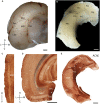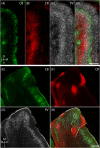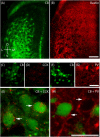Complementary Modular Microcircuits of the Rat Medial Entorhinal Cortex
- PMID: 28443003
- PMCID: PMC5385340
- DOI: 10.3389/fnsys.2017.00020
Complementary Modular Microcircuits of the Rat Medial Entorhinal Cortex
Abstract
The parahippocampal region is organized into different areas, with the medial entorhinal cortex (MEC), presubiculum and parasubiculum prominent in spatial memory. Here, we also describe a region at the extremity of the MEC and bordering the subicular complex, the medial-most part of the entorhinal cortex. While the subdivisions of hippocampus proper form more or less continuous cell sheets, the superficial layers of the parahippocampal region have a distinct modular architecture. We investigate the spatial distribution, laminar position, and putative connectivity of zinc-positive modules in layer 2 of the MEC of rats and relate them to the calbindin-positive patches previously described in the entorhinal cortex. We found that the zinc-positive modules are complementary to the previously described calbindin-positive patches. We also found that inputs from the presubiculum are directed toward the zinc-positive modules while the calbindin-positive patches received inputs from the parasubiculum. Notably, the dendrites of neurons from layers 3 and 5, positive for Purkinje Cell Protein 4 expression, overlap with the zinc modules. Our data thus indicate that these two complementary modular systems, the calbindin patches and zinc modules, are part of parallel information streams in the hippocampal formation.
Keywords: acetylcholinesterase; calbindin; mMEC; medial entorhinal cortex; modularity; parasubiculum; presubiculum; zinc.
Figures









Similar articles
-
Structural modularity and grid activity in the medial entorhinal cortex.J Neurophysiol. 2018 Jun 1;119(6):2129-2144. doi: 10.1152/jn.00574.2017. Epub 2018 Mar 7. J Neurophysiol. 2018. PMID: 29513150 Review.
-
Functional Architecture of the Rat Parasubiculum.J Neurosci. 2016 Feb 17;36(7):2289-301. doi: 10.1523/JNEUROSCI.3749-15.2016. J Neurosci. 2016. PMID: 26888938 Free PMC article.
-
Projections from the presubiculum and the parasubiculum to morphologically characterized entorhinal-hippocampal projection neurons in the rat.Exp Brain Res. 1994;101(1):93-108. doi: 10.1007/BF00243220. Exp Brain Res. 1994. PMID: 7843307
-
Regional and laminar organization of projections from the presubiculum and parasubiculum to the entorhinal cortex: an anterograde tracing study in the rat.J Comp Neurol. 1993 Feb 1;328(1):115-29. doi: 10.1002/cne.903280109. J Comp Neurol. 1993. PMID: 8429124
-
Architecture of the Entorhinal Cortex A Review of Entorhinal Anatomy in Rodents with Some Comparative Notes.Front Syst Neurosci. 2017 Jun 28;11:46. doi: 10.3389/fnsys.2017.00046. eCollection 2017. Front Syst Neurosci. 2017. PMID: 28701931 Free PMC article. Review.
Cited by
-
Microcircuits for spatial coding in the medial entorhinal cortex.Physiol Rev. 2022 Apr 1;102(2):653-688. doi: 10.1152/physrev.00042.2020. Epub 2021 Jul 13. Physiol Rev. 2022. PMID: 34254836 Free PMC article. Review.
-
Multiple Patterns of Axonal Collateralization of Single Layer III Neurons of the Rat Presubiculum.Front Neural Circuits. 2019 Jul 12;13:45. doi: 10.3389/fncir.2019.00045. eCollection 2019. Front Neural Circuits. 2019. PMID: 31354438 Free PMC article.
-
Local Microcircuitry of PaS Shows Distinct and Common Features of Excitatory and Inhibitory Connectivity.Cereb Cortex. 2021 Nov 23;32(1):76-92. doi: 10.1093/cercor/bhab195. Cereb Cortex. 2021. PMID: 34289029 Free PMC article.
-
Electrophysiological and Molecular Characterization of the Parasubiculum.J Neurosci. 2019 Nov 6;39(45):8860-8876. doi: 10.1523/JNEUROSCI.0796-19.2019. Epub 2019 Sep 23. J Neurosci. 2019. PMID: 31548233 Free PMC article.
-
Spatiotemporal Distribution of GABAA Receptor Subunits Within Layer II of Mouse Medial Entorhinal Cortex: Implications for Grid Cell Excitability.Front Neuroanat. 2018 Jun 4;12:46. doi: 10.3389/fnana.2018.00046. eCollection 2018. Front Neuroanat. 2018. PMID: 29915531 Free PMC article.
References
-
- Alonso A., Klink R. (1993). Differential electroresponsiveness of stellate and pyramidal-like cells of medial entorhinal cortex layer II. J. Neurophysiol. 70 128–143. - PubMed
-
- Altschul R. (1933). Die Glomeruli der Area praesubicularis. Z. Gesamte Neurol. Psychiatr. 148 50–54. 10.1007/BF02865159 - DOI
LinkOut - more resources
Full Text Sources
Other Literature Sources

